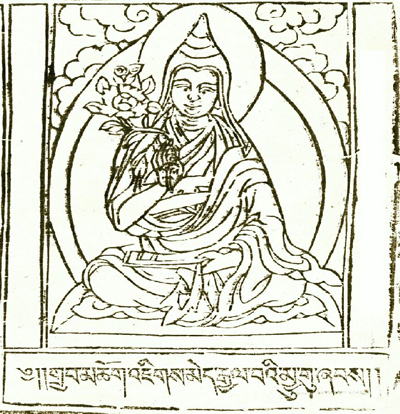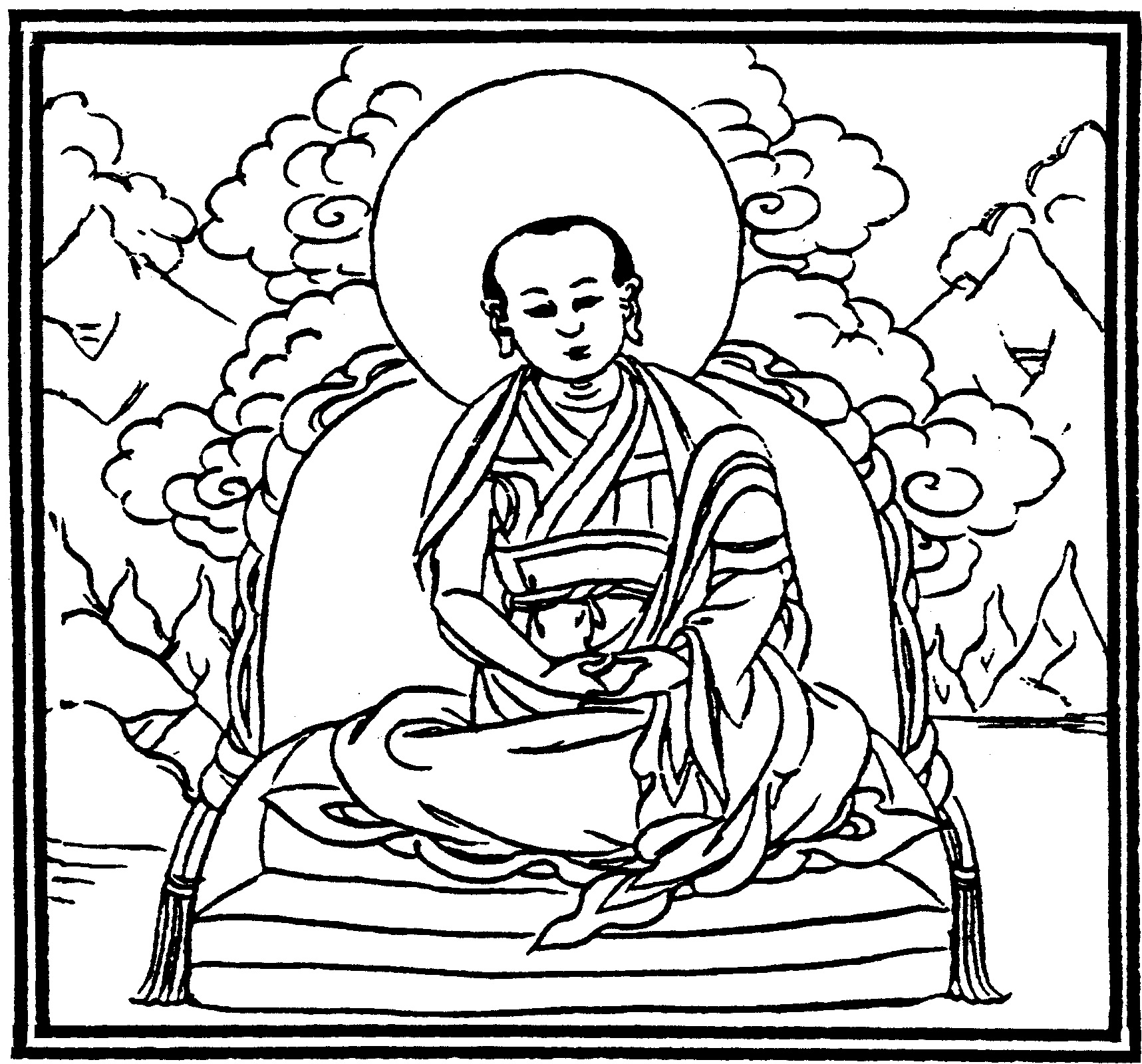Jigme Gyelwai Nyugu
Jigme Gyelwai Nyugu (‘jigs med rgyal ba’i myu gu) was born into the Getse (dge rtse) clan in the Dzachukha (rdza chu kha) region in Kham. His birth name was Pema Kunzang (pad+ma bkun bzang). His father, Orgyen Tashi (o rgyan bkra shis), was a member of the Dong lineage (ldong rigs) of the Mange clan (man dge). His mother was Tashi Kyi (bkra shis skyid).
His birth name was Pema Kunzang (pad+ma bkun bzang). His father, Orgyen Tashi (o rgyan bkra shis), was a member of the Dong lineage (ldong rigs) of the Mange clan (man dge). His mother was Tashi Kyi (bkra shis skyid).
At the age of fourteen Gyelwai Nyugu made a pilgrimage to Lhasa with members of his extended family. When he returned to Kham the Second Getse, Tsewang Rigdzin Gyatso (dge rtse 02 tshe dbang rig ‘dzin rgya mtsho) gave him instructions on Nyima Drakpa‘s (nyi ma grags pa) Tsasum Sangwa Nyingtik (rtsa gsum gsang ba nying thig) treasure, a popular Dzogchen teaching.
 Although Getse instructed him to continue his practice, because his father and several brothers had passed away, Gyelwai Nyugu was required to serve his family, traveling with his elder brother and doing business. Still, at seventeen Gyelwai Nyugu returned to Tibet on pilgrimage, this time with his mother. There he attempted to flee the pilgrimage party with a friend and take up the religious vocation, but family friends found him and forced him to return home.
Although Getse instructed him to continue his practice, because his father and several brothers had passed away, Gyelwai Nyugu was required to serve his family, traveling with his elder brother and doing business. Still, at seventeen Gyelwai Nyugu returned to Tibet on pilgrimage, this time with his mother. There he attempted to flee the pilgrimage party with a friend and take up the religious vocation, but family friends found him and forced him to return home.
At age eighteen he completed a hundred-day retreat under the instruction of Getse Lama, but the following year his elder brother died, and the pressure from his family to marry and assume householder responsibilities increased, a responsibility that even Getse urged him to accept. His mother, however, counseled him to leave, saying that were he to stay in the region he would only be pressed to fulfill his filial duties. She gave him a piece of silver and some tea and other provisions, and sent him off in secrecy.
Passing first through Dzogchen monastery, he met the Third Dzogchen Drubwang,Ngedon Tendzin Zangpo (rdzogs chen 03 nges don bstan ‘dzin bzang po), and gained a companion, Barchung Gomchung Rigdzin (‘bar chung rig ‘dzin) with whom he traveled to Tibet.
Not long after they were in Lhasa a thief conned Barchung out of the piece of silver by pretending to be a monk and offering to exchange it for currency. Gyelwai Nyugu was philosophical about losing their sole source of funds, and, fortunately, stating that it was their own lack of merit that disallowed them to use the silver for their religious pursuits.
Soon afterwards they traveled to Samye where they had the good fortune of meeting Dodrubchen Jigme Trinle Oser (rdo grub chen ‘jigs med phrin las ‘od zer), whom Gyelwai Nyugu’s companion had met previously at Dzogchen monastery. Jigme Trinle Oser invited them to go to Chimpu and practice with him, but first he suggested that they go meet with his own teacher, Jigme Lingpa, and receive instruction from him.
Following the First Dodrubchen’s advice, and carrying a letter of introduction her provided them, Gyelwai Nyugu and Barchung Rigdzin proceeded to Tsering Jong (tshe ring ljong) where Jigme Lingpa was residing. When he met Jigme Lingpa, Gyelwai Nyugu instantly felt that he had fulfilled his aspirations and prayers, and experienced a great joy and gratitude.
Starting that day Jigme Lingpa began instructing Gyelwai Nyugu. He gave him, among other things, instructions from the preliminary practice of the Sangwa Nyingtik, the empowerment from the Rigdzin Dupa (rig ‘dzin ‘dus pa) the guru yoga practice of the Longchen Nyingtik, his Yonten Dzod (yon tan mdzod), his exegesis of Nyingma philosophy. It was at this time that Jigme Lingpa gave his new disciple the name for which he was henceforth known, Jigme Gyelwai Nyugu.
Gyelwai Nyugu and Rigdzin Barchung then returned to Samye to train with Trinle Oser. Dodrubchen traveled with them to meet other lamas and visit other monasteries and sacred places in the area. They went to Mindroling, Dra Yongdzong (sgrags yang rdzong), Yeshe Tsogyel’s life-lake, Dramda temple (gra mda’i gtsug lag khang), and so forth.
For the next several years Gyelwai Nyugu remained in Tibet, serving as an attendant to Trinle Oser and sitting lengthy retreats. He received Changter (byang gter) instructions from Pema Shenyen (pad+ma bshes gnyen) and Chod teachings from Drubchen Tubten Tendzin (sgrub chen bstan bstan ‘dzin). He also returned to Tsering Jong to receive additional instruction from Jigme Lingpa, afterwards completing an arduous circumambulation of Tsari (rtsa ri) on his master’s advice, remaining on the mountain for a difficult nine-month retreat.
By 1793 Gyelwai Nyugu had returned to Kham, in the company of Dodrubchen. He initially stayed in the caves around the Dzogchen Monastery and at the Barchung Labrang. He next went to Dzachuka to Dodrubchen’s encampment at, but finding Dodrubchen away, he sat a hundred-day retreat in a nearby cave awaiting his return.
Following an additional retreat in the caves above Dzogchen monastery Gyelwai Nyugu returned to Tibet to meet with Jigme Lingpa once more, probably around 1795. For two and a half months he received teachings, but he declined to remain for the three year period Jigme Lingpa requested, explaining that he had obligations in Kham. Jigme Lingpa advised him to remain in retreat as much as possible, recommending that he teach those who come to him.
Upon his return to Kham Gyelwai Nyugu sat a three year retreat in at Getse, and then, in 1799, he went to Shugden Tago to assist Dodrubchen in the construction of Drodun Lhundrub (shugs chen stag mgo ‘gro don lhun grub gling), traveling with his teacher to the rulers of the nearby regions to raise the necessary funds.
For some twenty years Gyelwai Nyugu resided in caves in the Trama valley (khra ma lung) in upper Dzachuka, earning himself the title of “Hermit of Dzachuka” (rdza mtshams pa) and Dza Trama Lama (rdza khra ma bla ma). He lived under very austere conditions in the wild, sometimes under a rocky ledge, or even out in the open. Eventually students began to gather around the hermit lama. It was here that Dza Patrul Orgyen Jigme Chokyi Wangpo (rdza dpal sprul o rgyan ‘jigs med chos kyi dbang po) heard Gyelwai Nyugu’s teachings on the preliminaries twenty-five times, which became the basis for his Words of My Perfect Teacher (kun bzang bla ma’i zhal lung).
Although he was an accomplished master, Gyelwai Nyugu continued to receive empowerments and instructions from masters such as the the First DodrubchenJigme Trinle Ozer (‘jigs med ‘phrin las ‘od zer, 1745-1821), the young master Do Khyentse Yeshe Dorje (mdo mkhyen brtse ye shes rdo rje, 1800-1866), the great Getse Paṇchen Gyurme Chokdrub (dge rtse paN chen ‘gyur med mchog grub, 1761-1829), and the Fourth Dzogchen Rinpoche, Mingyur Namkhai Dorje (mi ‘gyur nam mkha’i rdo rje).
According to the instructions from Jigme Lingpa Gyelwai Nyugu continued to live under simple conditions in mountain hermitages. His students included Dza Patrul, Jamyang Khyentse Wangpo, and Gyelse Zhenpen Taye (rgyal sras gzhan phan mtha’ yas, 1800-1855).
Gyelwai Nyugu passed way at the age of seventy-nine, having greatly served sentient beings and furthered the teachings of the Longchen Nyingtik. His reincarnation, Pema Kunzang (jigs med rgyal ba’i myu gu 02 pad+ma kun bzang) was recognized by the Fourth Dzogchen Rinpoche.
Leave a Reply